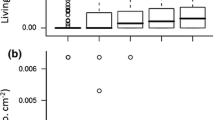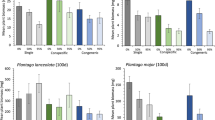Abstract
Recruitment is a crucial event in the plant life cycle that is very sensitive to interaction with established vegetation. Based on a large comparative experiment, we tested the hypothesis that the components of recruitment––emergence time and rate, seedling survival and biomass––differ in response to plant–plant interactions during recruitment. The consequences for the population are predicted with a simple demographic model assessing the response of seed production. In a common garden experiment, we recorded the recruitment of four target species in an individual-based survey protocol. A total of 7,680 seeds were sown within 20 neighbourhoods, consisting of 19 mono-specific herbaceous stands and a control treatment without vegetation. We measured transmitted light, temperature and moisture at soil surface to characterise the environmental conditions within neighbourhoods. The mean height of neighbours controlled temperature buffering and light interception and thus depicted the interaction gradient. Emergence rate and time increased with neighbour height in two of the four target species, while seedling survival and biomass significantly decreased with neighbour height in three and all four target species, respectively. We recorded a shift in seedling neighbour interactions under the tallest neighbours that largely favoured emergence but strongly depressed seedling survival and biomass. The components of recruitment were predicted to differ in their impact on later adult performance. Biomass strongly contributed to predicted seed production in three target species, and emergence had an equal or greater impact on a fourth species. These results confirm the fundamental role of plant–plant interactions in the recruitment of herbaceous species through a complex combination of habitat amelioration, which facilitates emergence and light competition, which in turn limits seedling survival and biomass.




Similar content being viewed by others
References
Aarssen L, Keogh T (2002) Conundrums of competitive ability in plants: what to measure? Oikos 96:531–542
Bertness M, Callaway R (1994) Positive interactions in communities. Trends Ecol Evol 9:191–193
Bruno J, Stachowicz J, Bertness M (2003) Inclusion of facilitation into ecological theory. Trends Ecol Evol 18:119–125
Bullock J (2000) Gaps and seedling colonization. In: Fenner M (ed) Seeds: the ecology of regeneration in plant communities, 2nd edn edn. CABI Publishing, Wallingford, UK
Callaway R, Walker L (1997) Competition and facilitation: a synthetic approach to interactions in plant communities. Ecology 78:1958–1965
Damgaard C (2004) Evolutionary ecology of plant-plant interactions. An empirical modelling approach. Aarhus University Press, Aarhus, Denmark
DeSteven D (1991a) Experiments on mechanisms of tree establishment in old-field succession––seedling emergence. Ecology 72:1066–1075
DeSteven D (1991b) Experiments on mechanisms of tree establishment in old-field succession––seedling survival and growth. Ecology 72:1076–1088
Eckstein R (2005) Differential effects of interspecific interactions and water availability on survival, growth and fecundity of three congeneric grassland herbs. New Phytol 166:525–536
Fenner M, Thompson K (2005) The ecology of seeds. Cambridge University Press, Cambridge, UK
Foster B (1999) Establishment, competition and the distribution of native grasses among Michigan old-fields. J Ecol 87:476–489
Freville H, Silvertown J (2005) Analysis of interspecific competition in perennial plants using life table response experiments. Plant Ecol 176:69–78
Garnier E et al (2004) Plant functional markers capture ecosystem properties during secondary succession. Ecology 85:2630–2637
Gaudet C, Keddy P (1988) A comparative approach to predicting competitive ability from plant traits. Nature 334:242–243
Goldberg D (1990) Components of resource competition in plant communities. In: Grace J, Tilman D (eds) Perspective on plant competition. Academic, San Diego, CA, pp 27–49
Goldberg D, Turkington R, Olsvig-Whittaker L, Dyer A (2001) Density dependence in an annual plant community: variation among life history stages. Ecol Monogr 71:423–446
Gross K, Werner P (1982) Colonizing abilities of “Biennial” plant species in relation to ground cover: implications for their distributions in a successional sere. Ecology 63:921–931
Grubb P (1977) Maintenance of species-richness in plant communities––importance of the regeneration niche. Biol Rev Camb Philos Soc 52:107–145
Harper J (1977) Population biology of plants. Academic, London
Hedges L, Gurevitch J, Curtis P (1999) The meta-analysis of response ratios in experimental ecology. Ecology 80:1150–1156
Holmgren M, Scheffer M, Huston M (1997) The interplay of facilitation and competition in plant communities. Ecology 78:1966–1975
Kitajima K, Fenner M (2000) Ecology of seedling regeneration. In: Fenner M (ed) Seeds: the ecology of regeneration in plant communities, 2nd edn. CABI, Oxon, UK
Leishman M (1999) How well do plant traits correlate with establishment ability? Evidence from a study of 16 calcareous grassland species. New Phytol 141:487–496
Liancourt P, Callaway R, Michalet R (2005) Stress tolerance and competitive-response ability determine the outcome of biotic interactions. Ecology 86:1611–1618
McGill B, Enquist B, Weiher E, Westoby M (2006) Rebuilding community ecology from functional traits. Trends Ecol Evol 21:178–185
Miriti M (2006) Ontogenetic shift from facilitation to competition in a desert shrub. J Ecol 94:973–979
Moles A, Westoby M (2004) What do seedlings die from and what are the implications for evolution of seed size? Oikos 106:193–199
Navas M, Ducout B, Roumet C, Richarte J, Garnier J, Garnier E (2003) Leaf life span, dynamics and construction cost of species from Mediterranean old-fields differing in successional status. New Phytol 159:213–228
Rees M, Grubb P, Kelly D (1996) Quantifying the impact of competition and spatial heterogeneity on the structure and dynamics of a four-species guild of winter annuals. Am Nat 147:1–32
Rousset O, Lepart J (2000) Positive and negative interactions at different life stages of a colonizing species. J Ecol 88:401–412
Samson D, Werk K (1986) Size-dependent effects in the analysis of reproductive effort in plants. Am Nat 127:667–680
Schiffers K, Tielbörger K (2006) Ontogenetic shifts in interactions among annual plants. J Ecol 94:336–341
Schwinning S, Weiner J (1998) Mechanisms determining the degree of size asymmetry in competition among plants. Oecologia 113:447–455
Suding K, Goldberg D (1999) Variation in the effects of vegetation and litter on recruitment across productivity gradients. J Ecol 87:436–449
Tremmel D, Bazzaz F (1993) How neighbour canopy architecture affects target plant performance. Ecology 74:2114–2124
Valiente-Banuet A, Vite F, Zavalahurtado J (1991) Interaction between the cactus Neobuxbaumia tetetzo and the nurse shrub Mimosa luisana. J Veg Sci 2:11–14
Violle C, Lecoeur J, Navas M (2007) How relevant are instantaneous measurements for assessing resource depletion under plant cover? A test on light and soil water availability in 18 herbaceous communities. Funct Ecol 21:185–190
Violle C, Richarte J, Navas M (2006) Effects of litter and standing biomass on growth and reproduction of two annual species in a Mediterranean old-field. J Ecol 94:196–205
Acknowledgments
The experiment conducted complied with French law. The authors are grateful to J. Richarte, E. Martinez, S. Villéger, C. Collin, J. Devaux, A. Blanchard and D. Degueldre for field assistance. They sincerely thank the ECOPAR group and O. Gimenez of the CEFE CNRS, M. Franco and an anonymous referee for their helpful comments and advice on earlier drafts of the manuscript. A.F. thanks A. Patry for help and encouragement throughout this project and invaluable corrections. This is a publication from the GEOTRAITS project (French National Programme ECCO-PNBC).
Author information
Authors and Affiliations
Corresponding author
Additional information
Communicated by Miguel Franco.
Rights and permissions
About this article
Cite this article
Fayolle, A., Violle, C. & Navas, ML. Differential impacts of plant interactions on herbaceous species recruitment: disentangling factors controlling emergence, survival and growth of seedlings. Oecologia 159, 817–825 (2009). https://doi.org/10.1007/s00442-008-1254-0
Received:
Accepted:
Published:
Issue Date:
DOI: https://doi.org/10.1007/s00442-008-1254-0




